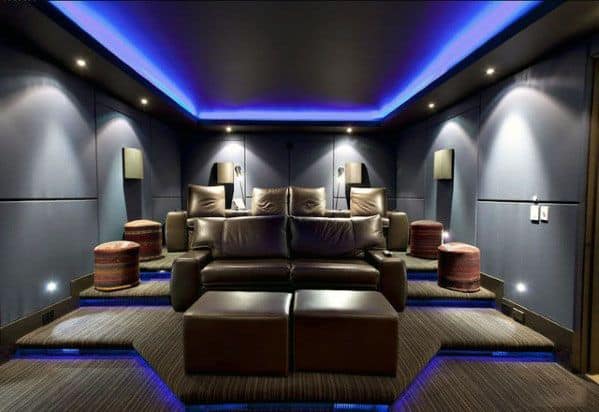Creating the perfect home cinema can be an exciting project, but it can also be quite expensive. One of the key elements that can make or break your home cinema experience is lighting. Good lighting can transform your viewing experience from ordinary to extraordinary, making your home cinema feel like a real theater. The good news is that you don’t need to spend a fortune to achieve great lighting. Here’s a guide on how to install home cinema lighting on a budget without sacrificing quality.
Understanding the Importance of Home Cinema Lighting
Why Lighting Matters
Lighting is a critical component of any home cinema setup. It affects not only the visual experience but also the overall ambiance of the room. Poor lighting can cause glare on the screen, eye strain, and a less enjoyable viewing experience. On the other hand, well-planned lighting enhances the picture quality, reduces eye fatigue, and creates a cozy and immersive atmosphere. It’s important to strike the right balance between too much light, which can wash out the screen, and too little light, which can make the room uncomfortable.
Types of Home Cinema Lighting
Before you start installing lighting, it’s useful to understand the different types of lighting available. Ambient lighting provides general illumination for the room and sets the overall mood. Task lighting focuses on specific areas, such as pathways or seating areas, to help you move around safely. Accent lighting highlights specific features in the room, such as artwork or architectural details. Each type of lighting plays a unique role in creating a well-rounded and comfortable home cinema environment.
Planning Your Lighting Setup
Note – Ready to transform your movie nights with the perfect Home Cinema Lighting? Contact Grandkolours today for expert advice and affordable solutions. Let us help you create the ultimate home theater experience on a budget. Reach out to Grandkolours now and light up your home cinema like never before!
Assessing Your Space
The first step in installing home cinema lighting is to assess your space. Consider the size and shape of the room, the location of the screen, and the seating arrangement. Take note of any windows or sources of natural light, as these can affect your lighting choices. Understanding the layout and features of your room will help you determine where to place lights and what type of lighting will work best.
Setting a Budget
Setting a budget is crucial for any home improvement project, especially when you’re looking to save money. Decide how much you’re willing to spend on lighting and stick to that budget. Remember that you don’t need to buy everything at once. You can start with the essentials and gradually add more lighting elements as your budget allows. Prioritizing your spending will help you get the most important components first and avoid overspending.
Choosing the Right Lighting
Once you have a clear understanding of your space and budget, it’s time to choose the right lighting. Look for affordable options that offer good quality and durability. LED lights are a great choice because they are energy-efficient, long-lasting, and available in a variety of styles. Consider using dimmable lights to adjust the brightness according to your needs. You can also use smart lighting systems that allow you to control the lights with your phone or voice commands, adding convenience and flexibility to your setup.
Installing Ambient Lighting
Ceiling Lights
Ceiling lights provide the main source of illumination in your home cinema. Recessed lights are a popular choice because they offer a clean and unobtrusive look. You can install them in a grid pattern across the ceiling to ensure even lighting throughout the room. Another option is to use a central ceiling light fixture, such as a chandelier or pendant light, for a more decorative touch. Make sure to choose dimmable lights so you can adjust the brightness to suit the mood.
Wall Lights
Wall lights, or sconces, are an excellent addition to any home cinema. They provide soft, indirect lighting that enhances the ambiance without causing glare on the screen. Place them at regular intervals along the walls to create a balanced look. Wall lights can also serve as decorative elements, adding style and character to your room. Look for affordable sconces that match the overall theme of your home cinema.
Adding Task Lighting
Pathway Lighting
Pathway lighting is essential for guiding viewers safely to their seats. This type of lighting is particularly useful if your home cinema is in a larger room or basement. Use LED strip lights along the edges of the floor or under the seats to illuminate the pathways. These lights are easy to install, energy-efficient, and available in various colors. Choose a soft, warm color to create a welcoming atmosphere.
Seating Area Lighting
Having proper lighting around the seating area is important for both comfort and safety. Table lamps or floor lamps placed near the seating can provide adequate illumination without disturbing the viewing experience. Look for lamps with adjustable brightness settings so you can customize the light levels. If you prefer a more integrated look, consider installing built-in lights in the seating itself. This can be a bit more expensive, but it offers a sleek and professional appearance.
Highlighting with Accent Lighting
Backlighting the Screen

Backlighting the screen can enhance the visual experience by reducing eye strain and improving contrast. This effect is achieved by placing LED strip lights behind the screen to create a halo of light. The soft glow helps your eyes adjust to the dark room, making the viewing experience more comfortable. LED strip lights are affordable and easy to install, making them a great budget-friendly option for backlighting.
Highlighting Room Features
Accent lighting can be used to highlight specific features in your home cinema, such as artwork, shelves, or architectural details. This adds depth and interest to the room, creating a more immersive environment. Use small, focused lights like spotlights or track lights to illuminate these features. LED puck lights are another great option for highlighting shelves or cabinets. These lights are inexpensive and can be installed with adhesive backing, making them easy to place anywhere you need.
Using Smart Lighting Solutions
Benefits of Smart Lighting
Smart lighting systems offer a convenient and flexible way to control your home cinema lighting. With smart lights, you can adjust the brightness, color, and even the schedule of your lights using a smartphone app or voice commands. This allows you to create the perfect lighting setup for different times of day and types of content. Smart lights are available in a range of prices, so you can find options that fit your budget.
Setting Up Smart Lighting
Setting up smart lighting is straightforward and can be done with minimal technical knowledge. Start by choosing a smart lighting system that suits your needs and budget. Popular options include Philips Hue, LIFX, and Wyze. Install the smart bulbs or smart plugs in your existing fixtures, and follow the instructions to connect them to your home Wi-Fi network. Once set up, you can control the lights using the accompanying app or through voice assistants like Amazon Alexa or Google Assistant.
Conclusion
Installing home cinema lighting on a budget is entirely possible with careful planning and smart choices. By understanding the importance of lighting, assessing your space, setting a budget, and choosing the right lighting options, you can create a comfortable and immersive home cinema experience without breaking the bank. Remember to start with the essentials and gradually add more lighting elements as your budget allows. Whether you’re using ambient lighting, task lighting, accent lighting, or smart lighting solutions, each type plays a vital role in enhancing your home cinema. With these tips, you’ll be well on your way to enjoying a top-notch movie-watching experience at home.
For more insightful articles related to this topic, feel free to visit businessblogs.com.au












